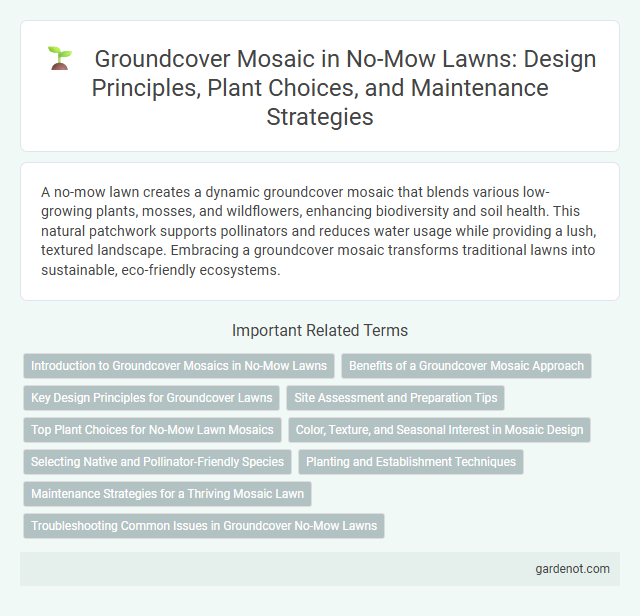A no-mow lawn creates a dynamic groundcover mosaic that blends various low-growing plants, mosses, and wildflowers, enhancing biodiversity and soil health. This natural patchwork supports pollinators and reduces water usage while providing a lush, textured landscape. Embracing a groundcover mosaic transforms traditional lawns into sustainable, eco-friendly ecosystems.
Introduction to Groundcover Mosaics in No-Mow Lawns
Groundcover mosaics in no-mow lawns create visually appealing and low-maintenance landscapes by combining various low-growing plants that thrive without regular mowing. These mosaics enhance biodiversity, improve soil health, and provide seasonal interest through diverse textures and colors. Selecting drought-tolerant and native species ensures sustainability and resilience in groundcover mosaic designs.
Benefits of a Groundcover Mosaic Approach
A groundcover mosaic approach enhances lawn biodiversity by combining multiple low-maintenance plant species that thrive without regular mowing. This method improves soil health and water retention through diverse root systems, reducing the need for fertilizers and irrigation. It also supports pollinators and beneficial insects, contributing to a sustainable and ecologically balanced landscape.
Key Design Principles for Groundcover Lawns
Groundcover mosaic lawns thrive by combining diverse low-growing plant species that provide continuous color, texture, and ecological benefits. Key design principles include selecting drought-tolerant and shade-adaptive plants, ensuring proper soil preparation to promote healthy root systems, and strategically spacing varieties to minimize weed growth while maximizing ground coverage. Incorporating native species enhances biodiversity and supports pollinators, creating sustainable, no-mow lawns that reduce maintenance and environmental impact.
Site Assessment and Preparation Tips
Conduct a thorough site assessment by evaluating soil type, drainage, and sun exposure to select the optimal groundcover species for a no-mow lawn. Remove existing vegetation and debris, then amend the soil with organic matter to improve fertility and structure before planting. Proper site preparation minimizes weed competition and promotes healthy, uniform groundcover establishment.
Top Plant Choices for No-Mow Lawn Mosaics
Creeping thyme, clover, and sedum are top plant choices for creating vibrant no-mow lawn mosaics due to their low growth habits and drought tolerance. These groundcovers provide diverse textures and colors while minimizing maintenance and water usage. Incorporating these species enhances soil health, supports pollinators, and ensures a sustainable, visually appealing no-mow lawn.
Color, Texture, and Seasonal Interest in Mosaic Design
Groundcover mosaics in no-mow lawns offer vibrant color palettes, ranging from deep purples to bright yellows, enhancing garden aesthetics year-round. The varied texture of plants like sedum, thyme, and creeping phlox creates a dynamic surface that replenishes itself without mowing. Seasonal interest is amplified by flowering cycles and foliage changes, promoting biodiversity and reducing maintenance effortlessly.
Selecting Native and Pollinator-Friendly Species
Selecting native and pollinator-friendly species for a groundcover mosaic enhances biodiversity and supports local ecosystems by providing essential habitats for bees, butterflies, and other pollinators. Native plants are well-adapted to regional soil, climate, and water conditions, reducing maintenance and promoting resilience against pests and diseases. Incorporating a diverse mix of flowering perennials like white clover, creeping thyme, and wild strawberries ensures continuous bloom cycles that attract pollinators throughout the growing season.
Planting and Establishment Techniques
Groundcover mosaic planting involves using a diverse mixture of low-growing, drought-tolerant plants to create a resilient, no-mow lawn alternative. Establishment techniques emphasize soil preparation, strategic spacing, and initial watering schedules to ensure optimal root development and ground coverage. Selecting native or well-adapted species reduces maintenance needs and enhances ecological benefits over time.
Maintenance Strategies for a Thriving Mosaic Lawn
Groundcover mosaic lawns thrive with minimal mowing by implementing strategic maintenance practices such as targeted watering, mulching, and periodic trimming of invasive species. Selecting drought-tolerant, low-growing groundcovers like creeping thyme or clover reduces water needs and promotes dense coverage that suppresses weeds. Regular soil aeration and organic fertilization enhance nutrient availability, supporting robust mosaic growth while preserving the no-mow paradigm.
Troubleshooting Common Issues in Groundcover No-Mow Lawns
Groundcover mosaic in no-mow lawns often faces challenges such as patchy growth, weed invasion, and soil compaction that hinder uniform coverage. Addressing these issues requires improving soil aeration, applying organic mulch to suppress weeds, and selecting resilient groundcover species like creeping thyme or clover. Regular monitoring for pest damage and adjusting watering schedules can enhance the health and aesthetic of the groundcover mosaic.
Groundcover mosaic Infographic

 gardenot.com
gardenot.com